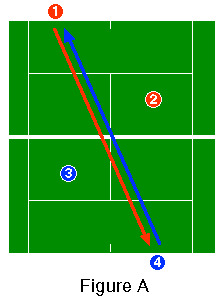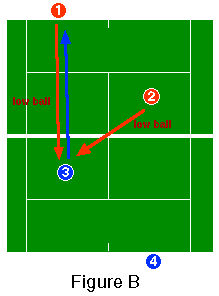<% ns_puts [nsv_get mkm_includes mkm_oldContentHeader_inc] %>
Strategy Lesson
of the Week
Doubles: How to Play Against a One Up/One Back Team
Strategy Question of the Week
How do we play against a team that plays one up (at the net) and one back
(at the baseline)?
Answer
(Note: This is a basic doubles lesson aimed at beginning and intermediate
club doubles players. For the sake of readability, it is assumed that these
are two female doubles teams).
First and foremost, your team needs to determine your own style of play
before you look over the net and decide how to play your opponents. Are
you a team that plays one up and one back like your opponents or are you
a team that tries to come to the net every chance you get? Once you
have determined your own style of play then and only then are you ready
to know how to face the opposition. In Part 1 of this answer, we'll
look at the strategy if you and your partner like to play one up and one
back.
Part 1: "One up/one back" vs "One up/one back"
Neutral or Defensive Play From the Baseline

When you're in a one-up/one-back formation playing another one up/one back
team, the general rule for all players is to keep the ball away from
the net person until you're ready to take the offensive.
If you're on the baseline (Player 1 or Player 4) playing against a one up/one
back team, you should hit the majority of your balls cross court--away from
the net person. In this one up/one back formation, it's the net person who
can do the most damage. The net person's closer position to the net enables
her to hit a whole variety of punishng shots (penetrating and jamming volleys,
extreme angled volleys and smashing overheads). So it's common sense: stay
away from the net person until you're ready to take the offensive.
Neutral or Defensive Play From the Net

If you're at the net (Player 3) playing against a one up/one
back team, and if you're hitting a low ball, follow the general rule (keep
it away from the net person) and hit your volley back to the baseline player.
Even if you pop up your volley from this low angle, the baseline player
is usually too far back in the court to take advantage of it (in contrast,
the opposing net person will kill your pop volley).
Next Page
<% ns_puts [nsv_get mkm_includes mkm_oldContentFooter_inc] %>

